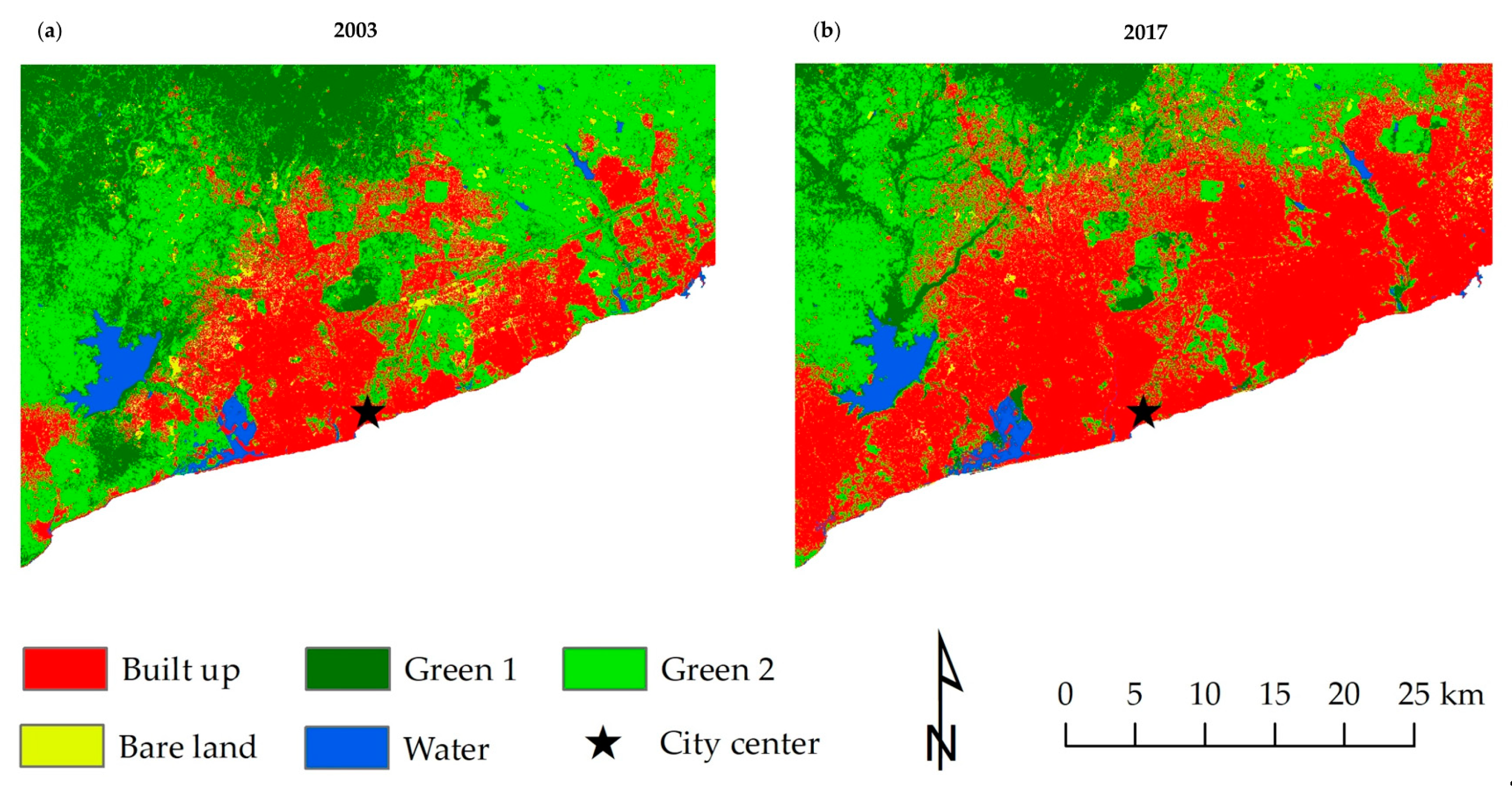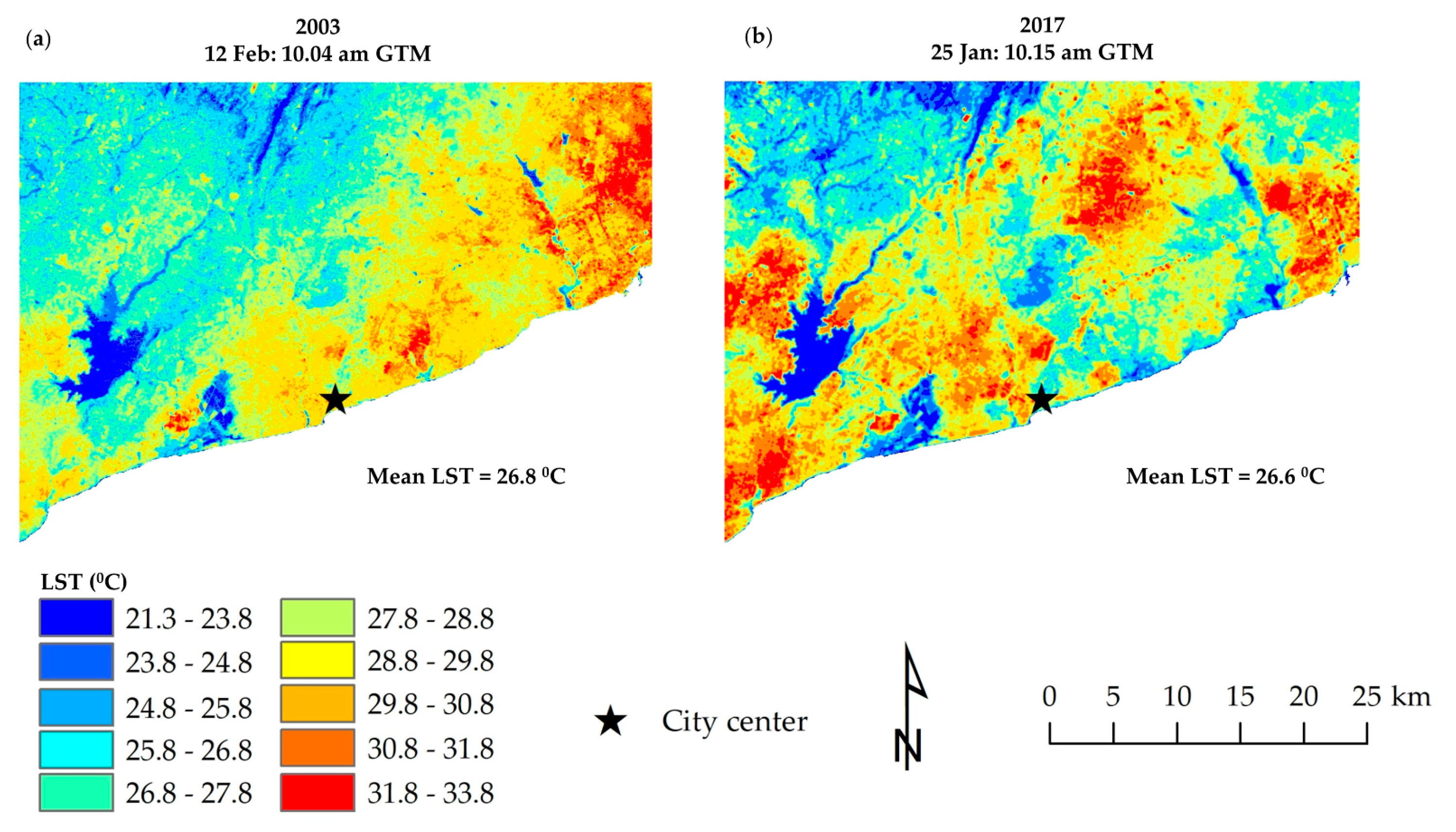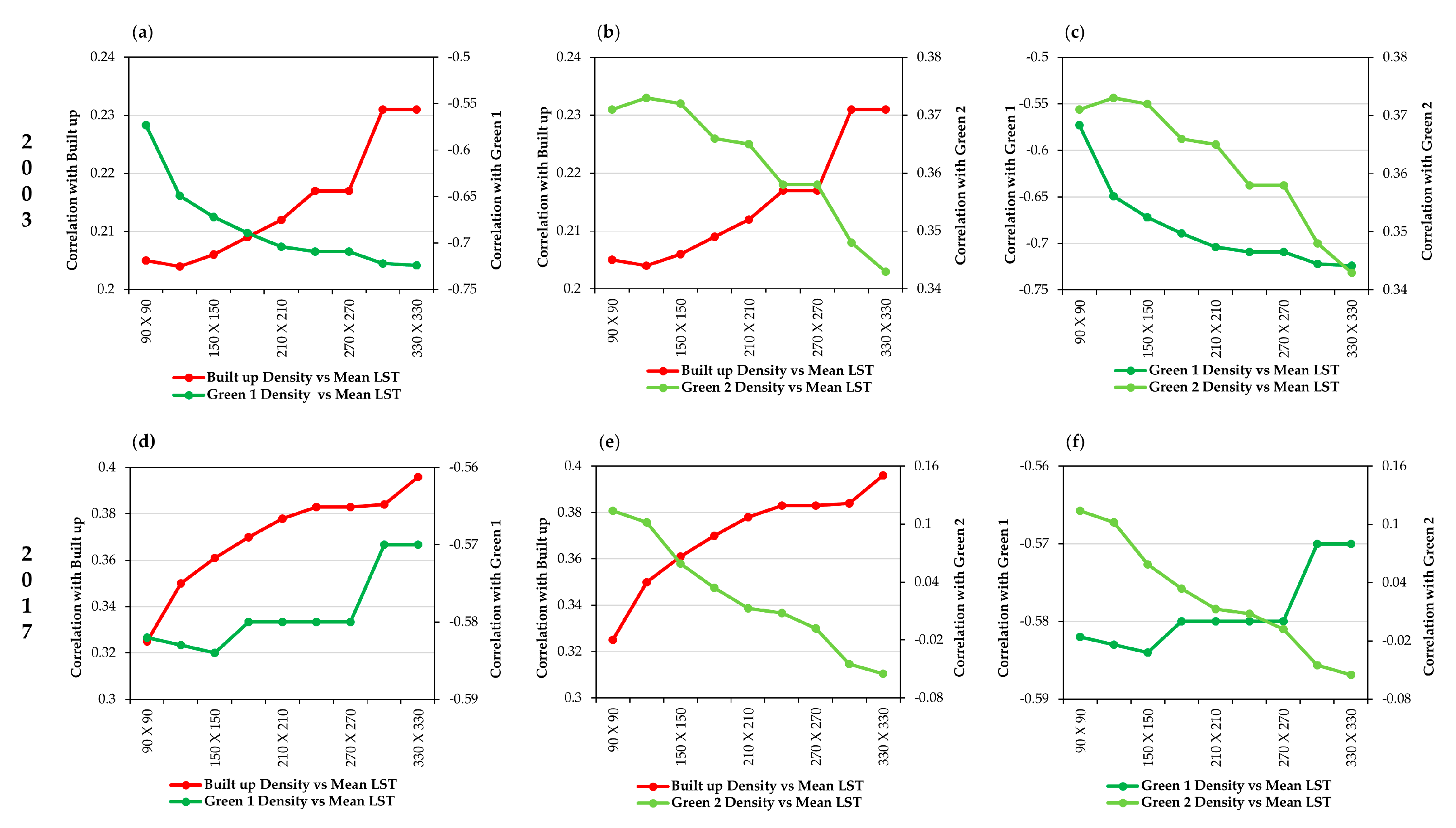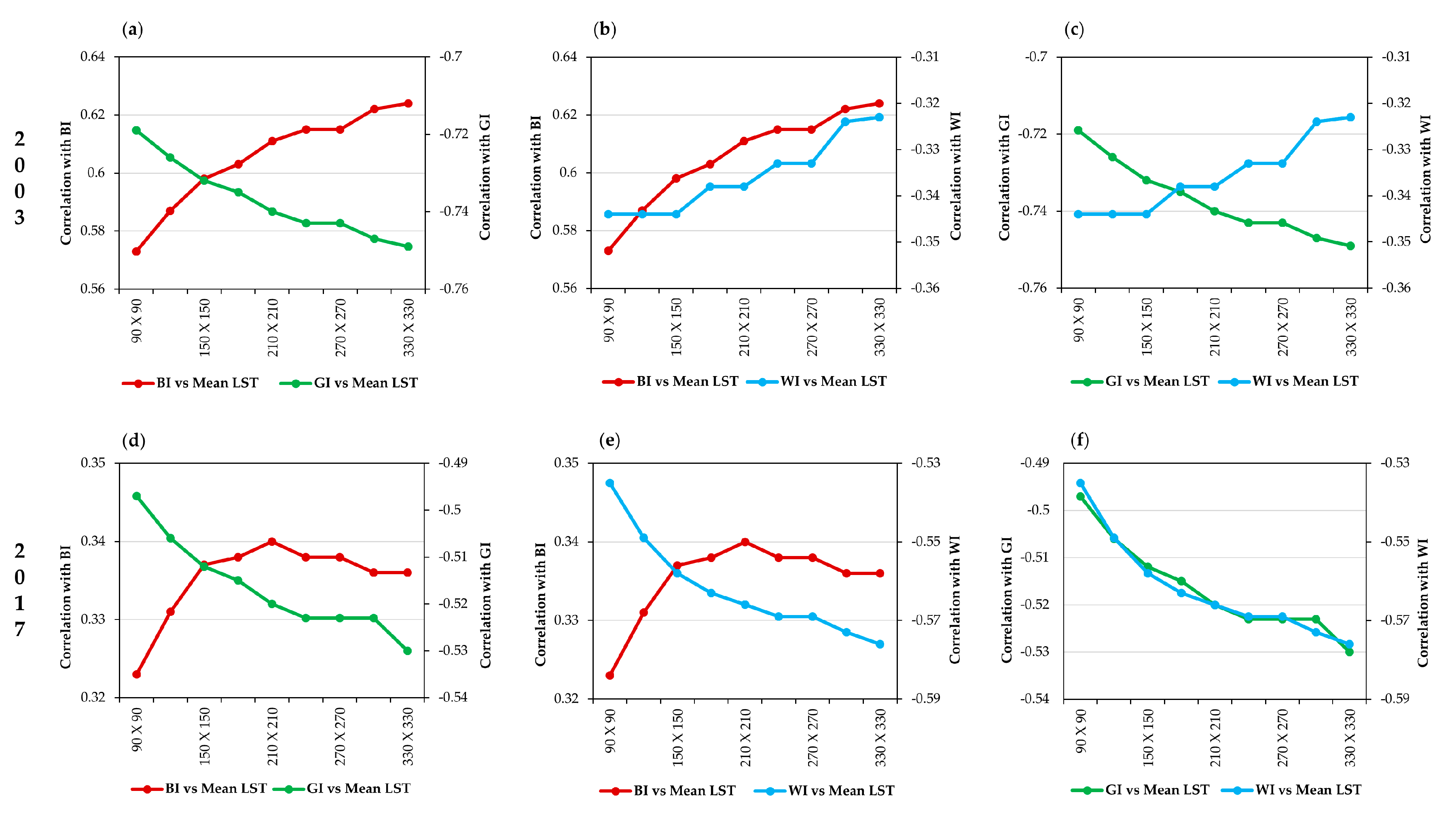Spatial Variation of Land Use/Cover Composition and Impact on Surface Urban Heat Island in a Tropical Sub-Saharan City of Accra, Ghana
Abstract
1. Introduction
2. Materials and Methods
2.1. Study Area
2.2. Satellite Data Used and Pre-Processing
- (a)
- Regarding Landsat 7 ETM:where, = the at-sensor spectral radiance (W/(m2 sr μm)), = spectral at-sensor radiance corresponding to (digital numbers (DN) = 255); = spectral at-sensor radiance correspondence to (W/(m2 sr μm)); = 255; = 1; and = the calibrated pixel value (DN) [31].
- (b)
- Regarding Landsat 8 OLI/TRIS:where, = the at-sensor spectral radiance (W/(m2 sr μm)); = scale factor multiplication of metadata; = scale factor of radiance for the metadata; and = DN pixel value [29].
- (a)
- Regarding Landsat 7 ETM:where, = TOA reflectance; = distance of the Earth and Sun (astronomical units); = constant (3.14159); = the at-sensor spectral radiance(W/(W/(m2 sr μm)); = the mean of exo-atmospheric solar irradiance; and is the angle of solar zenith [32].
- (b)
- Regarding Landsat 8 OLI/TRIS:where, = the TOA reflectance; = scale factor multiplication of metadata; = scale factor of radiance from the metadata; = DN pixel value; and = angle of solar elevation [33].
2.3. Retrieval of LST
2.4. LUC Classifications
2.5. Tasseled Cap Transformation (TCT)
2.6. Spatial Analysis of Accra
2.6.1. Urban-rural Gradient Analysis
2.6.2. Multiresolution Grid-Based Analysis
2.6.3. Landscape Metrics-Based Analysis
3. Results
3.1. Spatio-Temporal Change of LUC and LST (from 2003 to 2017)
3.2. TCT; LCCs vs. LST
3.3. Land Cover Density and TCT vs. Multiresolution Grid-Based Analysis
3.4. Landscape Metrics vs. LST
4. Discussion
4.1. Impacts of Urbanization
4.2. LST Pattern Along the Urban-Rural Gradient
4.3. Density of Land Lover Categories and TCT vs. LST at Multiresolution Grid-Based Analysis
4.4. Effect of Land Cover Features and Spatial Collocation vs. LST
5. Conclusions
Author Contributions
Funding
Acknowledgments
Conflicts of Interest
Appendix A

References
- Estoque, R.C.; Murayama, Y. Quantifying landscape pattern and ecosystem service value changes in four rapidly urbanizing hill stations of Southeast Asia. Landsc. Ecol. 2016, 31, 1481–1507. [Google Scholar] [CrossRef]
- Zhang, D.; Xu, J.; Zhang, Y.; Wang, J.; He, S.; Zhou, X.; Dan, Z.; Jiapeng, X.; Yizhu, Z.; Jing, W.; et al. Study on sustainable urbanization literature based on Web of Science, scopus, and China national knowledge infrastructure: A scientometric analysis in CiteSpace. J. Clean. Prod. 2020, 264, 121537. [Google Scholar] [CrossRef]
- Michishita, R.; Jiang, Z.; Xu, B. Monitoring two decades of urbanization in the Poyang Lake area, China through spectral unmixing. Remote Sens. Environ. 2012, 117, 3–18. [Google Scholar] [CrossRef]
- Weber, C.; Puissant, A. Urbanization pressure and modeling of urban growth: Example of the Tunis Metropolitan Area. Remote Sens. Environ. 2003, 86, 341–352. [Google Scholar] [CrossRef]
- Franco, S.; Mandla, V.R.; Rao, K.R.M. Urbanization, energy consumption and emissions in the Indian context A review. Renew. Sustain. Energy Rev. 2017, 71, 898–907. [Google Scholar] [CrossRef]
- Cao, H.; Chao, S.; Qiao, L.; Jiang, Y.; Zeng, X.; Fan, X. Urbanization-related changes in soil PAHs and potential health risks of emission sources in a township in Southern Jiangsu, China. Sci. Total Environ. 2017, 575, 692–700. [Google Scholar] [CrossRef]
- Shahbaz, M.; Sbia, R.; Hamdi, H.; Ozturk, I. Economic growth, electricity consumption, urbanization and environmental degradation relationship in United Arab Emirates. Ecol. Indic. 2014, 45, 622–631. [Google Scholar] [CrossRef]
- Al-Mulali, U.; Ozturk, I. The effect of energy consumption, urbanization, trade openness, industrial output, and the political stability on the environmental degradation in the MENA (Middle East and North African) region. Energy 2015, 84, 382–389. [Google Scholar] [CrossRef]
- Wang, Y.; Du, H.; Xu, Y.; Lu, D.; Wang, X.; Guo, Z. Temporal and spatial variation relationship and influence factors on surface urban heat island and ozone pollution in the Yangtze River Delta, China. Sci. Total. Environ. 2018, 631–632, 921–933. [Google Scholar] [CrossRef]
- Howard, L. The Climate of London; W. Phillips: London, UK, 1818; Volume 1. [Google Scholar]
- Estoque, R.C.; Murayama, Y.; Myint, S.W. Effects of landscape composition and pattern on land surface temperature: An urban heat island study in the megacities of Southeast Asia. Sci. Total Environ. 2017, 577, 349–359. [Google Scholar] [CrossRef]
- Voogt, J.; Oke, T. Thermal remote sensing of urban climates. Remote Sens. Environ. 2003, 86, 370–384. [Google Scholar] [CrossRef]
- USA Environmental Protection Agency. Reducing Urban Heat Islands: Green Roofs; Heat Island and Smog Reduction Act. Available online: https://www.epa.gov/heat-islands/heat-island-compendium (accessed on 23 September 2020).
- Zhou, D.; Zhao, S.; Liu, S.; Zhang, L.; Zhu, C. Surface urban heat island in China’s 32 major cities: Spatial patterns and drivers. Remote Sens. Environ. 2014, 152, 51–61. [Google Scholar] [CrossRef]
- Alexander, C. Normalised difference spectral indices and urban land cover as indicators of land surface temperature (LST). Int. J. Appl. Earth Obs. Geoinf. 2020, 86, 102013. [Google Scholar] [CrossRef]
- Estoque, R.C.; Ooba, M.; Seposo, X.T.; Togawa, T.; Hijioka, Y.; Takahashi, K.; Nakamura, S. Heat health risk assessment in Philippine cities using remotely sensed data and social-ecological indicators. Nat. Commun. 2020, 11, 1581. [Google Scholar] [CrossRef]
- Yiran, G.; Kusimi, J.M.; Kufogbe, S. A synthesis of remote sensing and local knowledge approaches in land degradation assessment in the Bawku East District, Ghana. Int. J. Appl. Earth Obs. Geoinf. 2012, 14, 204–213. [Google Scholar] [CrossRef]
- Estoque, R.C.; Murayama, Y. Monitoring surface urban heat island formation in a tropical mountain city using Landsat data (1987–2015). ISPRS J. Photogramm. Remote Sens. 2017, 133, 18–29. [Google Scholar] [CrossRef]
- Min, M.; Zhao, H.; Miao, C. Spatio-temporal evolution analysis of the urban heat island: A case study of Zhengzhou City, China. Sustainability 2018, 10, 1992. [Google Scholar] [CrossRef]
- Wu, Z.; Zhang, Y. Spatial variation of urban thermal environment and its relation to green space patterns: Implication to sustainable landscape planning. Sustainability 2018, 10, 2249. [Google Scholar] [CrossRef]
- Zhang, X.; Estoque, R.C.; Murayama, Y. An urban heat island study in Nanchang City, China based on land surface temperature and social-ecological variables. Sustain. Cities Soc. 2017, 32, 557–568. [Google Scholar] [CrossRef]
- Accra Metropolitan Assembly. Accra Resilience Strategy. Available online: https://ama.gov.gh/documents-centre.php (accessed on 23 September 2020).
- Warner, L.; van de Logt, P. Climate change profile Mali. Clim. Serv. Cent. 2015, 1–17. Available online: https://ees.kuleuven.be/klimos/toolkit/documents/690_CC_mali.pdf (accessed on 29 July 2020).
- Akubia, J.E.K.; Bruns, A. Unravelling the frontiers of urban growth: Spatio-temporal dynamics of land-use change and urban expansion in greater Accra metropolitan area, Ghana. Land 2019, 8, 131. [Google Scholar] [CrossRef]
- Esri ArcGIS Online. Available online: https://www.esri.com/en-us/arcgis/products/arcgis-online/overview (accessed on 23 September 2020).
- EarthExplorer. Available online: https://earthexplorer.usgs.gov/ (accessed on 29 July 2020).
- DIVA-GIS. Available online: https://www.diva-gis.org/ (accessed on 29 July 2020).
- Landsat Missions. Available online: https://www.usgs.gov/land-resources/nli/landsat (accessed on 29 July 2020).
- Adeyeri, O.; Akinsanola, A.; Ishola, K. Investigating surface urban heat island characteristics over Abuja, Nigeria: Relationship between land surface temperature and multiple vegetation indices. Remote Sens. Appl. Soc. Environ. 2017, 7, 57–68. [Google Scholar] [CrossRef]
- Weng, Q.; Lu, D.; Schubring, J. Estimation of land surface temperature–vegetation abundance relationship for urban heat island studies. Remote Sens. Environ. 2004, 89, 467–483. [Google Scholar] [CrossRef]
- Li, W.; Du, Z.; Ling, F.; Zhou, D.; Wang, H.; Gui, Y.; Sun, B.Y.; Zhang, X. A comparison of land surface water mapping using the normalized difference water index from TM, ETM+ and ALI. Remote Sens. 2013, 5, 5530–5549. [Google Scholar] [CrossRef]
- NASA. Landsat 7 Handbook. Available online: https://www.usgs.gov/core-science-systems/nli/landsat/landsat-7-data-users-handbook (accessed on 23 September 2020).
- U.S. Geological Survey. Landsat 8 Data Users Handbook. NASA. Available online: https://www.usgs.gov/core-science-systems/nli/landsat/landsat-8-data-users-handbook (accessed on 23 September 2020).
- Sobrino, J.A.; Jiménez-Muñoz, J.C.; Paolini, L. Land surface temperature retrieval from LANDSAT TM 5. Remote Sens. Environ. 2004, 90, 434–440. [Google Scholar] [CrossRef]
- Ayanlade, A.; Howard, M.T. Land surface temperature and heat fluxes over three cities in Niger Delta. J. Afr. Earth Sci. 2019, 151, 54–66. [Google Scholar] [CrossRef]
- R: The R Project for Statistical Computing. Available online: https://www.r-project.org/ (accessed on 30 July 2020).
- Kamusoko, C.; Aniya, M. Hybrid classification of Landsat data and GIS for land use/cover change analysis of the Bindura district, Zimbabwe. Int. J. Remote Sens. 2008, 30, 97–115. [Google Scholar] [CrossRef]
- Erkan, U.; Gokrem, L. A new method based on pixel density in salt and pepper noise removal. Turk. J. Electr. Eng. Comput. Sci. 2018, 26, 162–171. [Google Scholar] [CrossRef]
- Thapa, R.B.; Murayama, Y. Image classification techniques in mapping urban landscape: A case study of Tsukuba city using AVNIR-2 sensor data. Tsukuba Geoenviron. Sci. 2007, 3, 3–10. [Google Scholar]
- Kauth, R.J.; Thomas, G.S. The Tasselled Cap—A Graphic Description of the Spectral-Temporal Development of Agricultural Crops as Seen by LANDSAT. 1976. Available online: https://docs.lib.purdue.edu/cgi/viewcontent.cgi?referer=https://www.google.com.hk/&httpsredir=1&article=1160&context=lars_symp (accessed on 30 July 2020).
- Crist, E.P.; Cicone, R.C. A physically-based transformation of thematic mapper data—The TM tasseled cap. IEEE Trans. Geosci. Remote Sens. 1984, 22, 256–263. [Google Scholar] [CrossRef]
- Liu, Q.; Liu, G.; Huang, C.; Xie, C. Comparison of tasselled cap transformations based on the selective bands of Landsat 8 OLI TOA reflectance images. Int. J. Remote Sens. 2015, 36, 417–441. [Google Scholar] [CrossRef]
- Weng, Q. A remote sensing? GIS evaluation of urban expansion and its impact on surface temperature in the Zhujiang Delta, China. Int. J. Remote Sens. 2001, 22, 1999–2014. [Google Scholar] [CrossRef]
- Weng, Q.; Liu, H.; Lu, D. Assessing the effects of land use and land cover patterns on thermal conditions using landscape metrics in city of Indianapolis, United States. Urban Ecosyst. 2007, 10, 203–219. [Google Scholar] [CrossRef]
- Wang, C.; Myint, S.W.; Wang, Z.H.; Song, J. Spatio-temporal modeling of the urban heat island in the Phoenix metropolitan area: Land use change implications. Remote Sens. 2016, 8, 185. [Google Scholar] [CrossRef]
- Myint, S.W.; Wentz, E.A.; Brazel, A.J.; Quattrochi, D.A. The impact of distinct anthropogenic and vegetation features on urban warming. Landsc. Ecol. 2013, 28, 959–978. [Google Scholar] [CrossRef]
- Xiao, R.B.; Ouyang, Z.Y.; Zheng, H.; Li, W.F.; Schienke, E.W.; Wang, X.K. Spatial pattern of impervious surfaces and their impacts on land surface temperature in Beijing, China. J. Environ. Sci. 2007, 19, 250–256. [Google Scholar] [CrossRef]
- Maimaitiyiming, M.; Ghulam, A.; Tiyip, T.; Pla, F.; Latorre-Carmona, P.; Halik, Ü.; Sawut, M.; Caetano, M. Effects of green space spatial pattern on land surface temperature: Implications for sustainable urban planning and climate change adaptation. ISPRS J. Photogramm. Remote Sens. 2014, 89, 59–66. [Google Scholar] [CrossRef]
- Weng, Q. Thermal infrared remote sensing for urban climate and environmental studies: Methods, applications, and trends. ISPRS J. Photogramm. Remote Sens. 2009, 64, 335–344. [Google Scholar] [CrossRef]
- Myint, S.W.; Brazel, A.; Okin, G.S.; Buyantuyev, A. Combined effects of impervious surface and vegetation cover on air temperature variations in a rapidly expanding desert city. GISci. Remote Sens. 2010, 47, 301–320. [Google Scholar] [CrossRef]
- Hou, H.; Estoque, R.C. Detecting cooling effect of landscape from composition and configuration: An urban heat island study on Hangzhou. Urban For. Urban Green. 2020, 53, 126719. [Google Scholar] [CrossRef]
- Li, X.; Kamarianakis, Y.; Ouyang, Y.; Turner, B.L., II; Brazel, A. On the association between land system architecture and land surface temperatures: Evidence from a Desert Metropolis—Phoenix, Arizona, U.S.A. Landsc. Urban Plan. 2017, 163, 107–120. [Google Scholar] [CrossRef]
- Lu, L.; Weng, Q.; Xiao, D.; Guo, H.; Li, Q.; Hui, W. Spatiotemporal variation of surface urban heat islands in relation to land cover composition and configuration: A multi-scale case study of Xi’an, China. Remote Sens. 2020, 12, 2713. [Google Scholar] [CrossRef]
- Mcgarigal Fragstats. Fragstats. Available online: http://www.umass.edu/landeco/research/fragstats/fragstats.html (accessed on 23 September 2020).
- Zhang, X.; Zhong, T.; Feng, X.; Wang, K. Estimation of the relationship between vegetation patches and urban land surface temperature with remote sensing. Int. J. Remote Sens. 2009, 30, 2105–2118. [Google Scholar] [CrossRef]
- Li, X.; Zhou, W.; Ouyang, Z.; Xu, W.; Zheng, H. Spatial pattern of greenspace affects land surface temperature: Evidence from the heavily urbanized Beijing metropolitan area, China. Landsc. Ecol. 2012, 27, 887–898. [Google Scholar] [CrossRef]
- Cao, X.; Onishi, A.; Chen, J.; Imura, H. Quantifying the cool island intensity of urban parks using ASTER and IKONOS data. Landsc. Urban Plan. 2010, 96, 224–231. [Google Scholar] [CrossRef]
- Yokohari, M.; Brown, R.D.; Kato, Y.; Moriyama, H. Effects of paddy fields on summertime air and surface temperatures in urban fringe areas of Tokyo, Japan. Landsc. Urban Plan. 1997, 38, 1–11. [Google Scholar] [CrossRef]
- Addae, B.; Oppelt, N. Land-use/land-cover change analysis and urban growth modelling in the greater accra metropolitan area (GAMA), Ghana. Urban Sci. 2019, 3, 26. [Google Scholar] [CrossRef]
- Farvacque-vitkovic, C.; Eghoff, C. Development of the Cities of Ghana: Challenges, Priorities, and Tools; Africa Region Working Paper Series, World Bank Group. 2008. Available online: http://documents1.worldbank.org/curated/en/318351468256521007/pdf/448710NWP0Box31UBLIC10AFRWP0no10110.pdf (accessed on 23 September 2020).
- 2010 Population and Housing Census Final Results Ghana Statistical Service; Ghana Statistical Service: Accra, Ghana, 2012.
- Enhancing Urban Resilience in the Greater Accra Metropolitan Area. Available online: https://elibrary.worldbank.org/doi/abs/10.1596/27516 (accessed on 23 September 2020).
- Cities Alliance. Future Proofing Cities Metropolitan Cities in Ghana; Arup: London, UK, 2016. [Google Scholar]
- Gage, E.A.; Cooper, D.J. Urban forest structure and land cover composition effects on land surface temperature in a semi-arid suburban area. Urban For. Urban Green. 2017, 28, 28–35. [Google Scholar] [CrossRef]
- Yang, J.; Sun, J.; Ge, Q.; Li, X. Assessing the impacts of urbanization-associated green space on urban land surface temperature: A case study of Dalian, China. Urban For. Urban Green. 2017, 22, 1–10. [Google Scholar] [CrossRef]
- Rasul, A.; Balzter, H.; Smith, C. Spatial variation of the daytime surface urban cool island during the dry season in Erbil, Iraqi Kurdistan, from Landsat 8. Urban Clim. 2015, 14, 176–186. [Google Scholar] [CrossRef]
- Zhou, W.; Huang, G.; Cadenasso, M.L. Does spatial configuration matter? Understanding the effects of land cover pattern on land surface temperature in urban landscapes. Landsc. Urban Plan. 2011, 102, 54–63. [Google Scholar] [CrossRef]
- Zhou, W.; Wang, J.; Cadenasso, M.L. Effects of the spatial configuration of trees on urban heat mitigation: A comparative study. Remote Sens. Environ. 2017, 195, 1–12. [Google Scholar] [CrossRef]
- Peng, J.; Xie, P.; Yanxu, L.; Ma, J. Urban thermal environment dynamics and associated landscape pattern factors: A case study in the Beijing metropolitan region. Remote Sens. Environ. 2016, 173, 145–155. [Google Scholar] [CrossRef]
- Asgarian, A.; Amiri, B.J.; Sakieh, Y. Assessing the effect of green cover spatial patterns on urban land surface temperature using landscape metrics approach. Urban Ecosyst. 2014, 18, 209–222. [Google Scholar] [CrossRef]
- Masoudi, M.; Tan, P.Y.; Liew, S.C. Multi-city comparison of the relationships between spatial pattern and cooling effect of urban green spaces in four major Asian cities. Ecol. Indic. 2019, 98, 200–213. [Google Scholar] [CrossRef]








| Index | Band 1 | Band 2 | Band 3 | Band 4 | Band 5 | Band 6 | Equation No. |
|---|---|---|---|---|---|---|---|
| BI | 0.3037 | 0.2793 | 0.4743 | 0.5585 | 0.5082 | 0.1863 | 10 |
| GI | −0.2848 | −0.2435 | −0.5436 | 0.7243 | 0.0840 | −0.1800 | 11 |
| WI | 0.1509 | 0.1973 | 0.3279 | 0.3406 | −0.7112 | −0.4572 | 12 |
| Index | Band 2 | Band 3 | Band 4 | Band 5 | Band 6 | Band 7 | Equation No. |
|---|---|---|---|---|---|---|---|
| BI | 0.3029 | 0.2786 | 0.4733 | 0.5599 | 0.508 | 0.1872 | 13 |
| GI | −0.2941 | −0.243 | −0.5424 | 0.7276 | 0.0713 | −0.1608 | 14 |
| WI | 0.1511 | 0.1973 | 0.3283 | 0.3407 | −0.7117 | −0.4559 | 15 |
| Spatial metrics | Formula | Description | Units |
|---|---|---|---|
| Mean Patch Area (AREA_MN) | The spatial distribution and heterogeneity of the area; Area_MN calculates the patch area. | ha | |
| Mean Shape Index (SHAPE_MN) | Identify the shape complexity involving the LCCs. | ||
| Largest Patch Index (LPI) | LPI helps to identify the advantages of the LCCs. | 0–100 | |
| Aggregation Index (AI) | Measure class types aggregation levels in the area. | percentage |
| Built up | Green 1 | Green 2 | ||||||||||
|---|---|---|---|---|---|---|---|---|---|---|---|---|
| 2003 | 2017 | 2003 | 2017 | 2003 | 2017 | |||||||
| r | Sig. | r | Sig. | r | Sig. | r | Sig. | r | Sig. | r | Sig. | |
| AREA | 0.344 | 0.030 | 0.307 | 0.050 | −0.340 | 0.002 | −0.215 | 0.000 | 0.217 | 0.000 | 0.144 | 0.000 |
| SHAPE | 0.429 | 0.006 | 0.351 | 0.026 | −0.492 | 0.001 | −0.399 | 0.011 | 0.064 | 0.000 | 0.563 | 0.000 |
| LPI | 0.417 | 0.008 | 0.327 | 0.040 | −0.599 | 0.000 | −0.249 | 0.000 | 0.400 | 0.011 | 0.086 | 0.000 |
| AI | 0.583 | 0.000 | 0.210 | 0.000 | −0.686 | 0.000 | −0.272 | 0.089 | 0.270 | 0.091 | 0.175 | 0.000 |
© 2020 by the authors. Licensee MDPI, Basel, Switzerland. This article is an open access article distributed under the terms and conditions of the Creative Commons Attribution (CC BY) license (http://creativecommons.org/licenses/by/4.0/).
Share and Cite
Athukorala, D.; Murayama, Y. Spatial Variation of Land Use/Cover Composition and Impact on Surface Urban Heat Island in a Tropical Sub-Saharan City of Accra, Ghana. Sustainability 2020, 12, 7953. https://doi.org/10.3390/su12197953
Athukorala D, Murayama Y. Spatial Variation of Land Use/Cover Composition and Impact on Surface Urban Heat Island in a Tropical Sub-Saharan City of Accra, Ghana. Sustainability. 2020; 12(19):7953. https://doi.org/10.3390/su12197953
Chicago/Turabian StyleAthukorala, Darshana, and Yuji Murayama. 2020. "Spatial Variation of Land Use/Cover Composition and Impact on Surface Urban Heat Island in a Tropical Sub-Saharan City of Accra, Ghana" Sustainability 12, no. 19: 7953. https://doi.org/10.3390/su12197953
APA StyleAthukorala, D., & Murayama, Y. (2020). Spatial Variation of Land Use/Cover Composition and Impact on Surface Urban Heat Island in a Tropical Sub-Saharan City of Accra, Ghana. Sustainability, 12(19), 7953. https://doi.org/10.3390/su12197953






